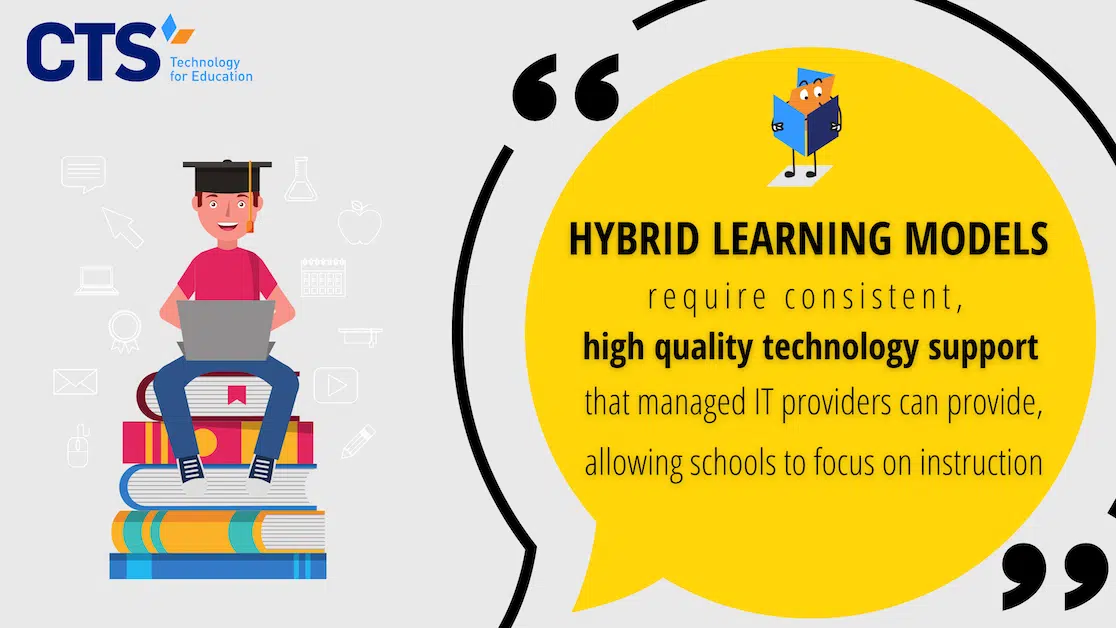COVID-19 has caused schools to embrace the idea of so-called hybrid learning models.
Last spring, as COVID-19 led to widespread school and business closures, technology became even more central to students’ and families’ daily lives. Without a brick-and-mortar school building to attend, students began engaging with one another via Zoom, Google Classroom, and other online learning platforms to a degree never before seen.
Terms like “breakout rooms,” “screen sharing,” and “Zoom bombing” entered families’ lexicons to describe the new normal of K-12 education, one defined by synchronous and asynchronous instruction, flexible scheduling, and, of course, almost constant technology use.
As schools look ahead to the 2021-22 academic year, many are reflecting on their experiences with remote learning and determining whether some, if not all, of the practices honed during the pandemic, make sense in a more traditional setting. Should the school really ask students to come to the building five days a week, or can administrators create “blocks” of students that rotate in and out of the building, depending on the day? How vital is synchronous instruction, particularly for advanced students with little trouble self-regulating? And finally, how can schools create a sustainable hybrid model with their existing technology resources?
The answer to this last question increasingly hinges on schools’ ability to meet their technology needs with their current IT teams. Often, the school finds that outsourcing their IT to a third party can dramatically improve the hybrid learning process, providing teachers, students, and family members with the kind of reliable technology support they need for students to learn virtually.
As schools think ahead to the next year, some are weighing the costs and benefits of a hybrid learning model.
On the one hand, schools are well aware of the frustrations associated with virtual and hybrid learning models. Technology snafus can derail an entire lesson plan, with students losing hours of instruction as a result. Teachers may not be able to monitor students’ performance as closely as they would like, and many kids need the type of in-person socialization that remote learning simply doesn’t provide. Finally, family members can also have difficulty coordinating their work schedules with those of their students’ hybrid or virtual learning classes.
With that said, some teachers, administrators, and family members point to some benefits associated with hybrid or virtual learning. First, many students thrive in a less structured, more self-regulated environment. Rather than sitting through long periods of instruction without a break, certain students perform better under hybrid or virtual learning conditions. When they need help or can’t understand a particular assignment, students engage their teacher virtually; when they don’t, they can work asynchronously and even end school early once they’ve completed their assignments. In this sense, at least, remote learning offers more flexibility to students who perhaps don’t succeed in traditional instructional environments.
Second, virtual learning often necessitates the use of online instructional platforms, many of which differentiate instruction in real-time for students. Depending on students’ performance, these online platforms adjust the content to which they expose students. If a child continues to miss problems involving the quadratic formula, for instance, the platform scaffolds the problems to provide additional practice and might even provide supplementary modules to solidify students’ understanding. By contrast, students who quickly master concepts are allowed to go “above and beyond” the content of the day’s lesson, accessing enrichment material they might not otherwise encounter in a traditional setting.
Outsourcing IT can benefit schools with hybrid learning models.
Given the centrality of technology to virtual or hybrid learning models, schools often find that outsourcing their IT to a third party gives them the kind of reliable technology support they need. Managed IT providers often have vastly more bandwidth and subject area expertise than a single in-house IT team member can provide. Third-party providers can also assist schools with the procurement process, obtaining lower prices for common technology products that significantly impact schools’ bottom line. Finally, managed IT teams can solve multiple problems at once: given their capacity, a managed IT provider can triage multiple incoming tickets simultaneously, providing teachers, families, and students with quick solutions to their frequent technology challenges.
At CTS, we help our partner schools accomplish their unique missions.
We’ve worked with more than 60 schools across the United States to rapidly scale their remote learning efforts. As our partner schools begin to think ahead to the next school year, our team has the know-how to ensure a smooth transition back to in-person or hybrid learning. Whether a school plans to embrace a traditional, hybrid, or virtual learning model, it can count on our team to provide consistent, high-quality IT support that provides peace of mind to teachers and positively impacts student achievement. Contact us today to learn more about our services and how we can help your school accomplish its unique mission.




